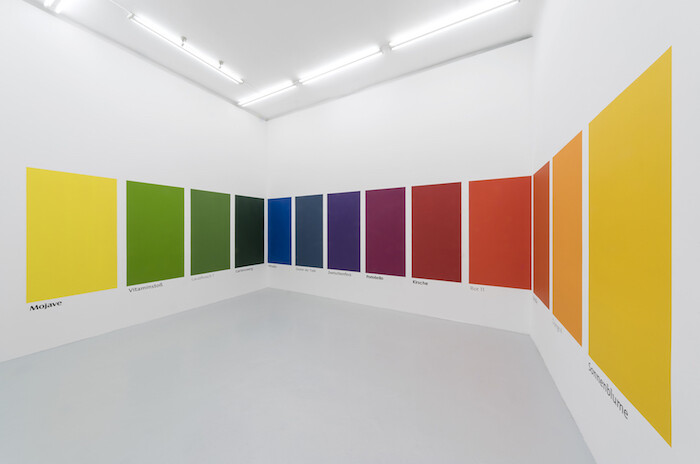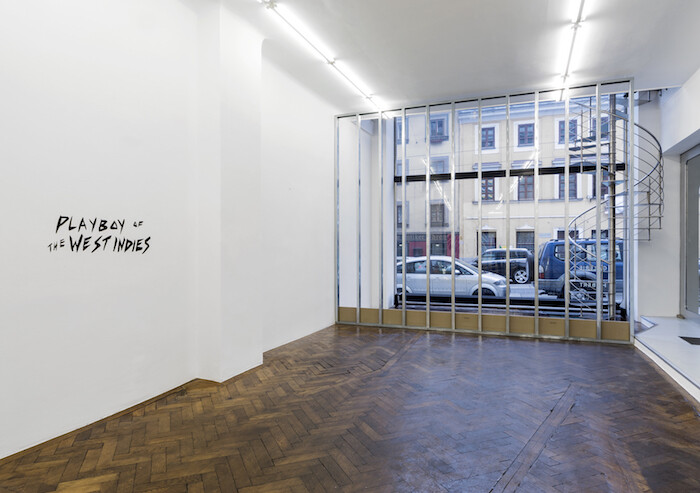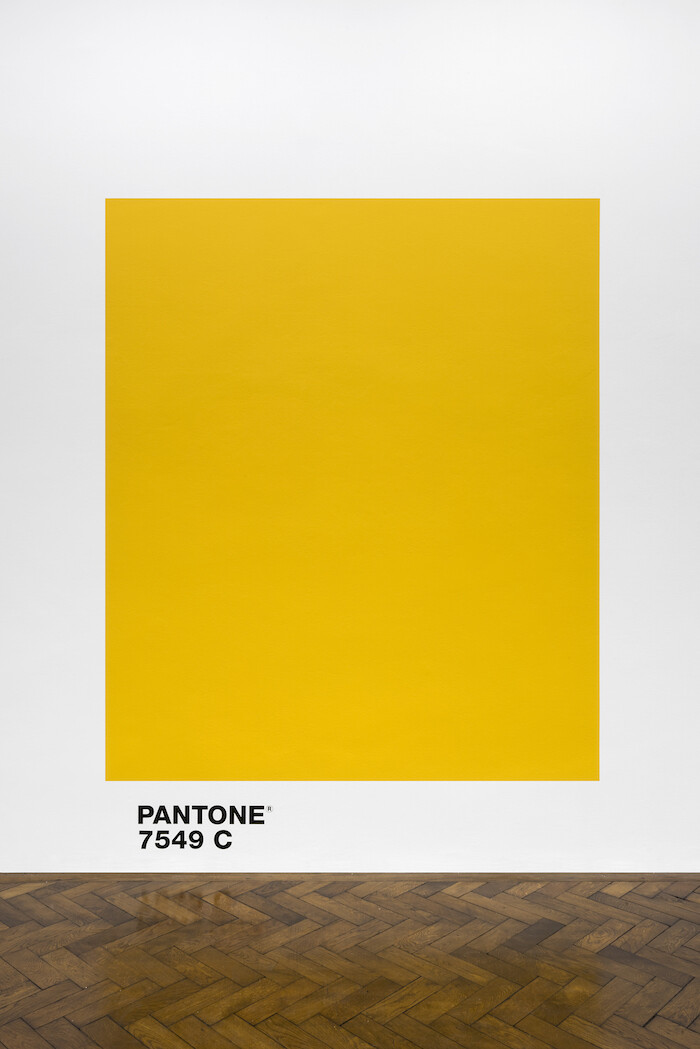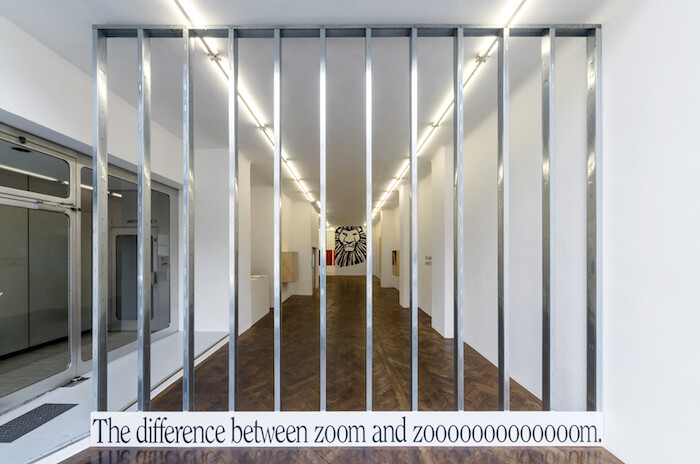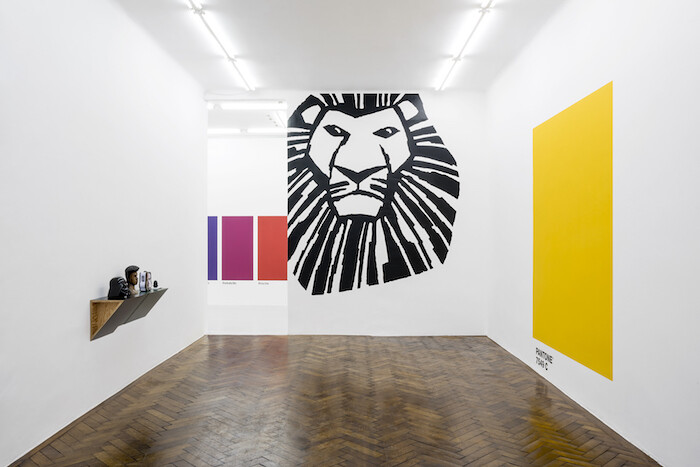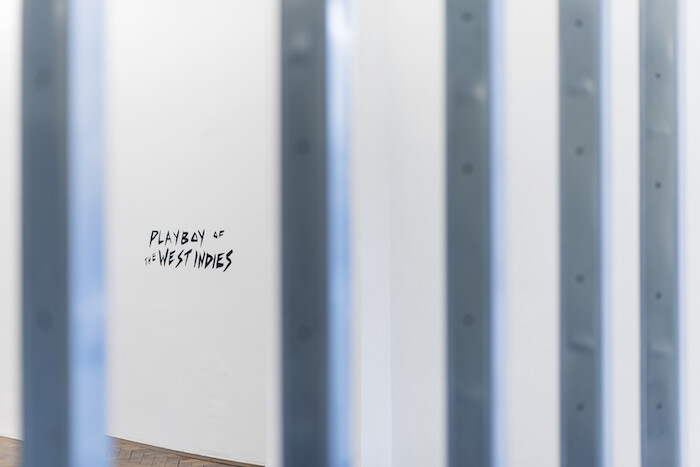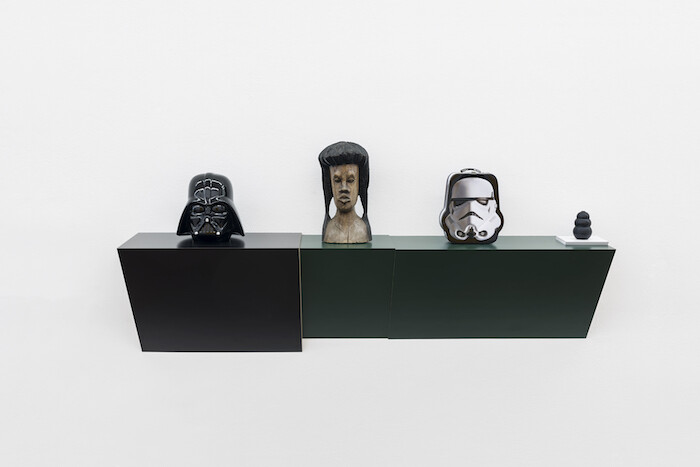“Mojave” is the name of the rectangular desert-yellow color furthest to the left in Haim Steinbach’s mural eswürdesoaussehen [itwouldlooklikethis] (2018). Painted on the back wall of the gallery, this 13-color dissection of an Ellsworth Kelly painting is individuated by English translations of the Austrian names of wall paint hues (Hitradio is “Loyal Blue,” Zwetschenfleck becomes “Plum cake”) written underneath the colored squares in their manufacturers’ branded typefaces. Placed at the back of the exhibition, it is both typical of Steinbach’s non-hierarchical organization of objects in the space and of his strategy of transferring commercial materials to the walls.
Three other mural works on view—the yellow Pantone color of pantone7549c (2018), playboy of the west indies (2018), and the lion king (2018)—reflect Steinbach’s long interest in brands and consumer products, as well as his 30-year battle with Marxist critics’ dismissive use of the term “commodity art” in relation to the “extreme ambivalence”1 of his practice, described variously as emulating “the narcotic rhythms of the marketplace”,2 or being “not unlike flower arranging.”3 Steinbach rejects Marxist concepts like commodification and labor, but his activities—evaluating, choosing, buying, arranging, and displaying items—are just like those of the consumer. For Marx, alienated labor immiserates individuals by distorting the true meaning of work. Ideally, people should realize their innermost needs and desires by seeing themselves in the finished product, but capitalist exploitation hands over the fruits of their troubles to their employer. Consumer society extends the alienation that arises from work to comprise feelings and modes of self-representation. Those who live within a consumer society see themselves not in what they make but in the in the things they buy and the social status they grant.
Steinbach readily exploits this situation by homing in on these emotional investments. He explains his aims with a mixed metaphor: he wants to show the visual grammar of his pieces’ interactions through their spatial placement in the space. Like in a living chessboard, the space organizes the interrelation between the different pieces poised for attack.
But maybe something more chaotic is going on here: perhaps the white cube is not a grid of columns and rows, but a kind of seismographic ticker tape charting the waves and flows of our feelings about the objects and their placement. The painted walls, plywood boxes Untitled (Pantone 18-2120) (2016) and Untitled (mutt) (2018), and shelving unit Untitled (cookie jar, Jamaican head, Stormtrooper, dog chew) (2018) are placed at different heights, denying viewers a privileged access point: they serve as vessels for multiple crisscrossing connections so that viewers cannot take up a unified view of the exhibition. This is epitomized in Display #91 – the difference between zoom and zooooooooooooom. (2018), a series of galvanized steel studs that look like prison bars, whose title appears written on plasterboard at its bottom. Stretching the width of the gallery and nestled between the window and the main exhibition space, it plays with the territory of the exhibition. If the work was truly inside the space, viewers would have to step over it. To see it in full, it’s necessary to leave the gallery and look at it from the street. But this gesture obstructs the view to other works. Looking through the cage, the proud mane of the lion king becomes the solemn head of a zoo animal, hinting at the layers of exploitation behind the objects that appear on the shelves, though there is no promise of liberation here.
The shelf Untitled (cookie jar, Jamaican head, Stormtrooper, dog chew) comprises a ceramic Darth Vader-shaped cookie jar, a hand-carved Jamaican wood bust, a metal Stormtrooper lunchbox, and a tiny rubber dog chew. If Steinbach’s artistic activity could transfigure the objects he collects and displays, the shelf would turn the cookie jar and lunchbox (which bear the heads of cinema villains) into parodies of marble busts of the sort of Roman emperors whose power they imitate, the dog chew into a Neolithic Venus, and question whether the wood-bust is a piece of folk art or tourist tat. Without the category of labor, however, no such transformation is possible.
“Mojave” lets viewers map the non-hierarchical connections between these objects, shapes, and colors, charting how the purely formal qualities of each of them travel through time and traverse the art-historical canon—not just Kelly, but also Josef Albers, early Kazimir Malevich, and neo-geo—but Steinbach cannot be absolved of political responsibility. He homes in the contemporary investment in the seductive intensity of material things and the memories we associate with them, but never criticizes the various degrees of alienation that prop up the system.
In a famous account of the Westin Bonaventure Hotel in Los Angeles, philosopher Fredric Jameson describes its creator—businessman, architect, and millionaire developer John C. Portman—as “an artist who is at one and the same time a capitalist in his own right.”4 Ultimately, Steinbach is an artist who is at one and the same time a visual merchandiser in his own right, dutifully arranging retail-style floor plans and three-dimensional displays that leave its visitors at the mercy of their own desires.
Holland Cotter, “Haim Steinbach: Shelf Life,” Art in America 76, no. 6 (May 1988): 160.
Edward Ball, “The Beautiful Language of My Century,” Arts Magazine (January 1988), 70.
John Miller, “The Consumption of Everyday Life,” Artscribe International (January-February 1988), 49.
Fredric Jameson, Postmodernism, or the Cultural Logic of Late Capitalism (London: Verso, 1991), 44.


